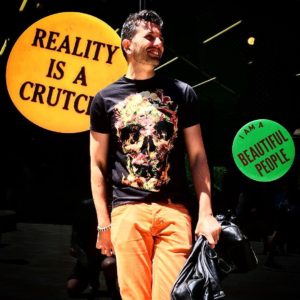 It might seem that I am trying to demonstrate the unreality of reality. Many others have done so, including Taoists, Hindus and Buddhists. Jews, Christians and Muslims, following Plato’s lead, think God’s ideal realm is realer than this world. Religious people are not the only ones to call reality an illusion. Ludwig Wittgenstein said, “The limits of my language mean the limits of my world,” and Jacques Derrida suggested, “There is nothing outside the text.”
It might seem that I am trying to demonstrate the unreality of reality. Many others have done so, including Taoists, Hindus and Buddhists. Jews, Christians and Muslims, following Plato’s lead, think God’s ideal realm is realer than this world. Religious people are not the only ones to call reality an illusion. Ludwig Wittgenstein said, “The limits of my language mean the limits of my world,” and Jacques Derrida suggested, “There is nothing outside the text.”
Instead, my purpose is to show that the distinction between fiction and reality is artificial, created by language. Fiction and reality both exist as concepts within the same linguistic structure; symbols and stories are essential parts of our reality system. Everything we talk and write about is fiction, yet fiction has material existence, therefore it is real. Separating fiction from reality only drives us, like Don Quixote, to narrative madness.
Recognizing how fiction is our reality will not cure our insanity, but the realization will give us more freedom to reconstruct reality. The purpose of speech and writing is after all is not to record or comment on the world, as the Greeks suggested, but to act upon the world, to shape it and make sense of it. On the other hand, most of our actions are symbolic, referencing linguistic roles. When I stand before a class, I am saying, “I am the teacher. Listen to me.” A whole scene is suggested by the placement of my body. Speech is action and action is language. To understand what we are doing and saying, we must recognize that language and action are part of the same symbolic system.
How can we really know who we are within this complex narrative system? Metafiction can help. Metafiction is an attempt by a narrator to step outside of the story (although this is impossible — a narrator merely trades one fiction for another). Metafiction is defined in The Oxford English Dictionary as “Fiction in which the author self-consciously alludes to the artificiality or literariness of a work” — in other words, metafiction is fiction about fiction. The dictionary tells us that metafiction exposes the artificiality of a work “by parodying or departing from novelistic conventions (esp. naturalism) and narrative techniques.” Note that in this definition “naturalism” is the primary target of metafiction. And I would add “non-fiction” to the list of opponents.
By playing with convention and technique, metafiction can help us recognize “the artificiality or literariness” of our letters, words, sentences, paragraphs, chapters, narrators, speakers, readers, settings, characters, dialogues, actions and narrative structures. I will be using metafiction then to show not only that we are as mad as Don Quixote, but to show how understanding our narrative madness can help us find our place within a more complete reality system.
As an example, dictionaries are written in the voice of a “nobody speaker.” If nobody is saying it, the definition seems objective and absolute. Yet we can catch the individuality of the speaker of the definition above if we look closely. He or she wrote about “the author” alluding to the artificiality or literariness of a work, while a literary scholar would have used the term “the narrator.” In other words, a particular attitude towards writers and narrators is expressed: that they are the same person. If we recognize that definitions are not absolute, then we gain a bit more power over our words, a bit more authority.
In order to rehabilitate reality, I will be examining metafiction across the centuries, especially three works that refer to Don Quixote: Miguel de Cervantes’ El ingenioso hidalgo don Quixote de la Mancha, Laurence Sterne’s The Life and Opinions of Tristram Shandy, Gentleman, and Jorge Luis Borges’ “Pierre Menard, Author of the Quixote.” Robert Coover’s “Dedicatorio y Prólogo a don Miguel de Cervantes Saavedra” and Kathy Acker’s Don Quixote will also be useful at times. Although these texts will comprise my principal material, I will borrow freely from other metafictional texts and meta works in other media to make my point.
An important question to consider for this project is whether metafiction has had its day. The word “metafiction” was coined by William H. Gass in an essay, “Philosophy and the Form of Fiction,” in 1970 and is primarily associated with postmodern fiction of the 50’s, 60’s, and 70’s. The use of the word “metafiction” peaked around 1990 and has been falling ever since (according to Google Ngram Viewer, which tracks the frequency of words in hundreds of thousands of books). Yet meta-elements are appearing more often in film, advertisements, photos, comics, sculpture — even food and fashion. New uses of the prefix are appearing: metablog, metadata, metawidget, metameme, metagaming, meta-joke, metaverse and metahumans. And the truth is we need metafiction more than ever.
(This is the fifth part of six part series, following “Fiction and Reality” and followed by “Relevance in the Age of Information and Consumerism.” To read more, check out my book Narrative Madness, available at narrativemadness.com or on Amazon.)